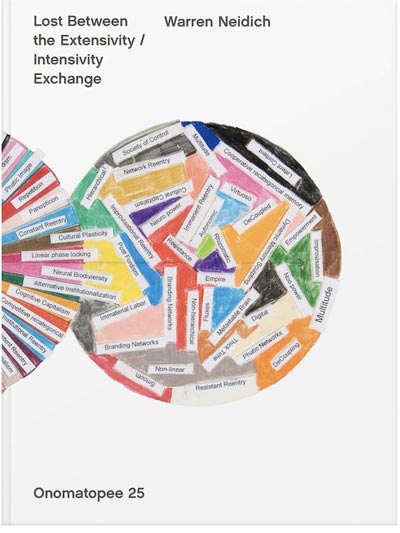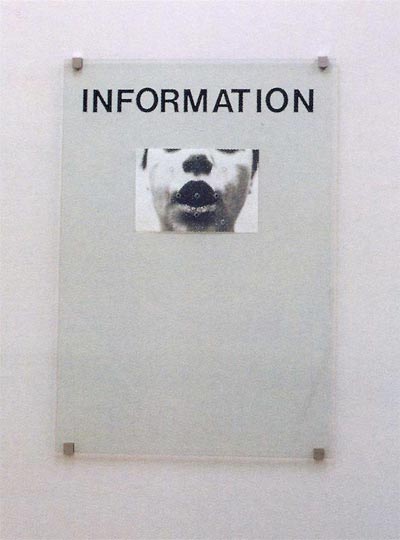
[su_spacer]
Introduction:
In the publication Lost Between the Extensivity-Intensivity Exchange published in 2008 by Onomatopee I brought forth the notion, through diagramatic and textual displays, that the inauguration of the 21st century could be described as a time of cultural torpor resulting from free floating anxiety, ambivalence, and wavering. The causes for this condition were many, but two stood out. First and foremost was the condition, suggested by the title, that of being lost in the ‘in-between zone’ of extensive and intensive labor and two evolving partially incommensurable world views, the local (tribal) and global (cosmopolitan) or the nation-state and the Earthling, merged. Superimposed upon this unstable frame of reference was, and still is, the disparity in epistemology encountered by the subject in the urban designed space of the city and its rural counterpart, although this difference is being quickly eroded away with the advent of fast connection internet and cheap hand-held browsing devices. Could the gridlock in the American Congress and David Cameron’s recent veto against the European Community be a result of this ensuing torpor, representing a clash between those of us who want to embrace a world view and those of us who want to recede into smaller more homogenous communities characteristic of the past? The question then needs to be reframed as: is this appropriate in today’s world that requires solutions to global issues like global warming, workers’ rights, and international terrorism? How, on one hand do we preserve local cultures and practices from global homogenization, while at the same time giving people all over the world the benefits of a global society like antibiotics, education for woman, and better sanitation – just to name a few. How do we soothe the needs of those who require familiarity and constancy with the requirements of those who want to move forward into cosmopolitanism or the idea of the ‘world citizen’?
[su_spacer]

[su_spacer]
It is to these conditions that I would like to direct this essay in the hope of finding a way out of this languor by creating a more productive rhetoric, a trans-thinking vocabulary that does not heed the restrictions of a language rooted either in the humanities or the sciences but a mixture of the two. By trans-thinking I want to address a state of mind that is free floating and unencumbered by contrived barriers constructed in thought itself. As will be argued shortly, we are moving out of a condition of strict neoliberalism; a ‘cognitive turn’ has taken place. Ideas around the brain and mind are playing more and more of a role in investment strategy and political policy. Anyone regularly reading the New York Times will be impressed by the frequency and range of articles concerning mind and brain recently published. In the month of December alone, eleven articles have been published. These articles have ranged from advice on how exercise benefits the brain, to a critique of the limits of neuroscience when researching works of art to a bevy of articles concerning traumatic injuries to the head in ice hockey and soccer.
With the advent of the Internet and the explosion of images created by new media, issues of attention have also become more and more important and with it, maladies like Attention Deficit Disorder (ADD) due to the lack of the ability to focus. In our attention economy, in order to be an adequate consumer, you need your skills of attention to be at their peak. Lack of or easily disrupted attention in the 21st century is a disability that needs to be treated, and the pharmaceutical companies have been all too happy to invent a pharmaceutical menagerie to do so. ADD as well as Depression, according to Franco Berardi, are part and parcel of a whole host of disabilities particular to our time. (1) “The other side of the new economy is naturally the use of psycho-stimulant or anti-depressive substances…How many, among new economy operators, survive without Prozac, Zoloft or even cocaine…When economic competition is the dominant psychological imperative of the social consortium, we can be positive that the condition for mass depression will be produced. This is in fact happening under our eyes.” (2) It is here upon this playing field that a new ethics must be formed and refusing a lexicon of humanism or science just won’t do. Furthermore, the idea of free market unencumbered by political restrictions and decisions is an idea that has no merit today, for cognitive capitalism is focused on the new territory of the mind and brain, specifically its decision-making processes which skews any reference to free choice which neo-liberalism requires. Consumer neuroscience itself is a wild card in the hand of neo-liberalism. (3)These issues would seem to be a far cry from any discussion of artist residencies. But artist residency programs are, in fact, the perfect site in which to explore a variety of arguments concerning notions of tribalism vs. cosmopolitanism; extensive and intensive labor; the representation of the other in a world of mass immigration and transnationalism; and free choice in neo-liberalism. By their very nature artist residency programs are forms of temporary settlements in a worldwide nomadic movement of peoples and ideas, and as a result, they embody notions of cultural contamination and semiocapitalism. ‘The rise of post-Fordist modes of production, which I will call Semiocapitalism, takes the mind, language and creativity as its primary tools for the production of value.’ (4) Just as Gilles Deleuze had to create a different language to redefine Michel Foucault’s ideas of ‘the disciplinary society’ with his term the ‘society of control’, today we need to redefine other concepts, such as the artist-in-residence, to make them relevant in contemporary discourse. (5)
[su_spacer]

[su_spacer]
Each epoch, driven by novel sets of immaterial social, political, psychological, and spiritual relations, must devise new linguistic modifications to capture the essences of these mutated cultural environments, so too must we understand that the artist-inresidence operates in a very different discursive field today than it did, say, in the late 19th century and early 20th century when patrons of the arts created the Corporation of Yaddo. In our moment of a network transnational society, other cultures with other languages and other ideas become essential to the production of a complex point-of-view that has the potential to produce complex brains. I want to show how the artist-inresidence might play a role in this, first by concentrating the cultural capital of the other and secondly by activating this ‘otherness’ with the marginal and dissociative apparatuses of aesthetic production. I want to invoke it as a place where the power of art might flex its muscle.
The essay is divided up into a number of sections. Section 1, entitled The building without a program or how the physical condition of the space of the residency might be mutated, sketches out the potential of the residency as a cultural modifier acting to release its innate plasticity, potentiality in reserve. Utilizing the idea invented by Deleuze of the ‘body without organs’ as a metaphor, the residency is likened to a body that is no longer subjected to the despotism of the a priori genetic plan and is released to express another side of itself. For instance, surrealism and its instigator Freudian psychoanalysis were understood as tools in the elaboration of a new organization of the cultural landscape in early modernism. As such, this essay outlines the ways in which it, through the rules of its practices, mutated the complex contingencies of the aesthetic-cultural landscape of its time. Thus, it elicited alternative reactions from the brain’s attention centers, creating, in response, elaborate changes in the materiality of the neurobiological substrate that might be registered as memory architectures. These restructurings and neural modulations are then shown to have resonance for a model of sculpting of the phantasmagoric relations of the phantom limb and its phenomena of remapping. This plasticity metaphor, in this case cultural plasticity, is also utilized to understand architecture as a malleable space in which the regulation of social and intellectual flows that determine a residency, could be unlocked to affect and mold the surrounding cultural landscape in which it is embedded, with the potential to produce novel circuits in the brain/mind complex that make sense of it. Section 2 Cultural Pluripotentiality and Neuroplasticity: Parallelactic Continuity and Discontinuity further develops this idea. Cultural pluripotentiality refers to the relation of the dominant culture to the minority cultures that orbit around and through it. Healthy cultures are continually in flux. Metaphorically speaking they are a multiplicity of instructional and informational resonances vibrating at different frequencies that are tethered together in time as a meshwork or network phenomena. The sum total of these significations gives rise to that culture’s identity and quality. Whether you are looking at the micro-cultural context of the tribe, clan or nation-state, or molar condition of the transnational empire, one cultural referendum usually predominates. This dominant culture controls the center of the network of relations and is thus involved in dominating that portion of the network’s activity, as all of its resonances eventually move through the center. At the margins this is less true. Although the dominant culture controls the character, principles and general intelligence of a particular tribe, nation state or transnational entity under moments of destabilization due to war, natural disasters, economic downfall or extreme paradigm shift, the network’s disposition might change. In this moment, the marginal culture might have the chance to express itself more intensely. For instance, these moments of destabilization might de-center the network making what was peripheral and marginal more central. I think this is what happened after Catherine David’s, Documenta X and Okwui Enwezor’s Documenta XI as together, one could argue, they were partly responsible for the cultural turn in art history. This process of destabilization and restabilization as something else is essential for the concept of cultural pluripotentiality as a form of cultural plasticity that constitutes a culture resiliency in times of change by allowing for the establishment of different intensities. In this moment of cognitive capitalism – delineated by immaterial labor and new forms of distributed general and machinic intelligence – the redistribution of the network’s capacity and the rearrangement of its immanent nodal identity is more important than ever. This cultural pluripotentiality is coupled to the conditions of the brain’s neural plasticity. As such, this cultural-neurobiologic plasticity complex, as I would like to call it, provides a mechanism for continued natural selection and survival.
Section 3, entitled Neurobiopolitics: The Mind’s Eye as a Place of Political and Social Contention, explores the notion of biopolitics of the mind. Biopower, as defined by Michel Foucault, constitutes the methods through which sovereignty constitutes docile and productive bodies and organizes life through the modulations of affect, for example, pleasure. (6) In cognitive capitalism, the brain and mind are the focus of sovereignty’s desire to normalize the subject’s gnostic potential in order to produce a ‘like minded’ people. This constitutes one of the conditions of neurobiopolitics. When neurobiopolitics focuses specifically on the neural plastic potential of the brain especially in the frontal lobes where it is most abundant, the term ‘neuropower’ is used. In tertiary economies it has been argued by the likes of Poalo Virno that the virtuouso performance leaves no trace. (7) It does not produce any material product. Through my project The Noologist’s Handbook (2008-2011), I argue that in late capitalism a trace is, in fact, left in the form of complex memory structures in the mind’s eye. Secondly I argue that this space of the mind’s eye is one of political contention and political determination. I then explain how a ‘residency without walls’ adapts to the rubric of the early 21st century and embraces this idea of the immaterialization of architecture as a mechanism by which to unhinge regimes of oppression that attempt to debilitate it as a cultural and neurobiological modifier. In Section 4, The Cultural Capitalism/Cognitive Capitalism Ratio and its Relation to Cerebral Complexity, I define my concept of the Cultural Capitalism / Cognitive Capitalism Ratio and tether it to cultural complexity. As opposed to the usual definition of cultural capitalism proposed by Pierre Bourdieu, in which cultural capital refers to those factors that include the cultural habits and dispositions inherited from the family and which are fundamentally important for a child’s success in school and therefore society, I put forth an alternative position in which cultural capital is seen as the degree to which artistic practices create other resistant possibilities for the mind by neural modulation. (8) I would like to expand Bourdieu’s position because it is not broad enough and does little to examine the emancipating aspects of cultural capital. I am extending it to include the idea that these same resources form the fundamental epistemological context that later inform the practices of those children that become artists and architects. This specialized knowledge becomes the fundamental platform though which they produce novel intellectual products and discourses, especially in the cognitive regime, to interact with those conditions of cognitive capitalism in order to mutate them. Beyond the definitions of cognitive capital currently circulating in the public’s eye as espoused by a group of Italian political philosophers such as Maurizio Lazzarato, Matteo Pasquinelli, Titziana Terranova and Christian Marrazzi, I would like to add the following: cognitive capitalism refers to a recent accentuation of an ongoing historical process in which the territory of the mind and brain is the focus of capital investment. Most importantly, cognitive capital organizes its apparatuses of power upon the brain’s neuroplasticity in the hope of producing a future passive and normalized human being. This, as we saw above, is called neuropower and will be elucidated later. I then proceed to explain what I call the ‘Cultural Capital/Cognitive Capital Ratio’, where a high ratio delineates an open society whilst a small value connotes a repressive one. In the following section called Further Elucidation of the Cultural Capital / Cognitive Capital Ratio and Neuromodulation, I investigate how this ratio could serve as indices for predicting how the neuroplasticity of the neural tissue is sculpted and modulated within specific political cultural environments. After a detailed discussion of neuroplasticity and its relation to epigenesis, I go on to discuss its link to cultural production. In this respect I tether this ratio to the concept of complexity both in culture and in the brain. The coupling of cultural complexity to what is referred to as degeneracy forms the final discussion in this section. Cultural complex environments that embrace high levels of cultural capital produce degenerate networks in the brain that give that brain a greater capacity to think creatively and improvisationally.
Excerpt